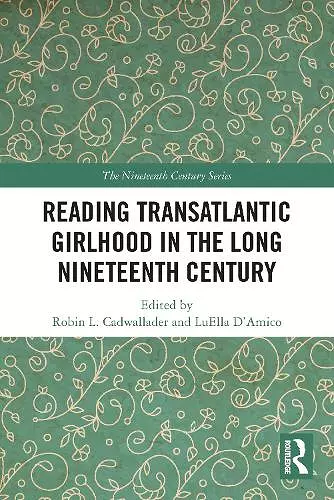Reading Transatlantic Girlhood in the Long Nineteenth Century
LuElla D’Amico editor Robin L Cadwallader editor
Format:Paperback
Publisher:Taylor & Francis Ltd
Published:31st May '23
Currently unavailable, and unfortunately no date known when it will be back
This paperback is available in another edition too:
- Hardback£145.00(9780367274962)

This collection is the first of its kind to interrogate both literal and metaphorical transatlantic exchanges of culture and ideas in nineteenth-century girls’ fiction. As such, it initiates conversations about how the motif of travel in literature taught nineteenth-century girl audiences to reexamine their own cultural biases by offering a fresh perspective on literature that is often studied primarily within a national context. Women and children in nineteenth-century America are often described as being tied to the home and the domestic sphere, but this collection challenges this categorization and shows that girls in particular were often expected to go abroad and to learn new cultural frames in order to enter the realm of adulthood; those who could not afford to go abroad literally could do so through the stories that traveled to them from other lands or the stories they read of others’ travels. Via transatlantic exchange, then, authors, readers, and the characters in the texts covered in this collection confront the idea of what constitutes the self. Books examined in this volume include Adeline Trafton’s An American Girl Abroad (1872), Johanna Spyri’s Heidi (1881), and Elizabeth W. Champney’s eleven-book Vassar Girl Series (1883-92), among others.
The front matter of this excellent volume states that it looks at “literal and metaphorical transatlantic exchanges of culture and ideas.” Taking girls' fiction seriously and focusing on actual and imagined travel, the collection investigates the pedagogical and imaginary value of fiction about girls traveling across the Atlantic. Cadwallader (Saint Francis Univ.) and D'Amico (Univ. of the Incarnate Word) point out that some privileged girls actually traveled across the Atlantic, but many more were engaged by travel narratives. In these pages, readers will encounter various 19th-century novels and series that either included some travel (e.g., Lucy Maud Montgomery's Anne of Green Gables) or focused entirely on travel. Elizabeth Champney's "Three Vassar Girls" series foregrounded the nascent category of college women in the US. Kate Wiggin's Penelope series, though ending in marriage for the protagonist, suggests further travels and mobility. Mary Jane Holmes wrote novels that gave girls, as protagonists, spatial opportunities afforded by travel. Most of the contributors find moments or themes of transgressive gender agency on the part of girls, and in her contribution, Cadwallader finds Adeline Trafton's An American Girl Abroad to offer a cautionary tale. All the essays are well written and a pleasure to read. Summing Up: Recommended.
--A. N. Valdivia, University of Illinois at Urbana-Champaign
ISBN: 9780367499174
Dimensions: unknown
Weight: 430g
226 pages